Abstract
The addition of 5 mg of streptomycin sulfate per ml to the drinking water of Swiss white mice resulted in a 100,000-fold reduction in the 50% implantation dose of streptomycin-resistant Salmonella typhimurium for the animals. When streptomycin-treated and untreated mice were challenged orogastrically with 10(3) viable S. typhimurium organisms, 100% of the treated and none of the untreated mice excreted the pathogen in their feces. Similarly, translocation of S. typhimurium from the intestinal tract to the liver, spleen, and mesentery occurred in 10 of 10 treated mice but in none of the untreated mice 7 days after challenge with 10(3) CFU. Studies of colonization dynamics showed that S. typhimurium was present at high population levels in the intestines of streptomycin-treated mice and in detectable levels in the liver, spleen, and mesentery within 72 h after challenge with 10(3), 10(5), or 10(8) organisms. In untreated mice challenged with either 10(3) or 10(5) S. typhimurium organisms, the organisms were isolated from ileal and cecal tissues but not from ileal or cecal contents or from extraintestinal tissue 72 h after challenge. When untreated mice were challenged with 10(8) organisms, however, S. typhimurium was present in all organs and in intestinal contents. Streptomycin treatment, therefore, facilitated colonization and development of streptomycin-resistant S. typhimurium populations in intestines of mice and the subsequent translocation of the organisms from the intestinal tract to other tissues.
Full text
PDF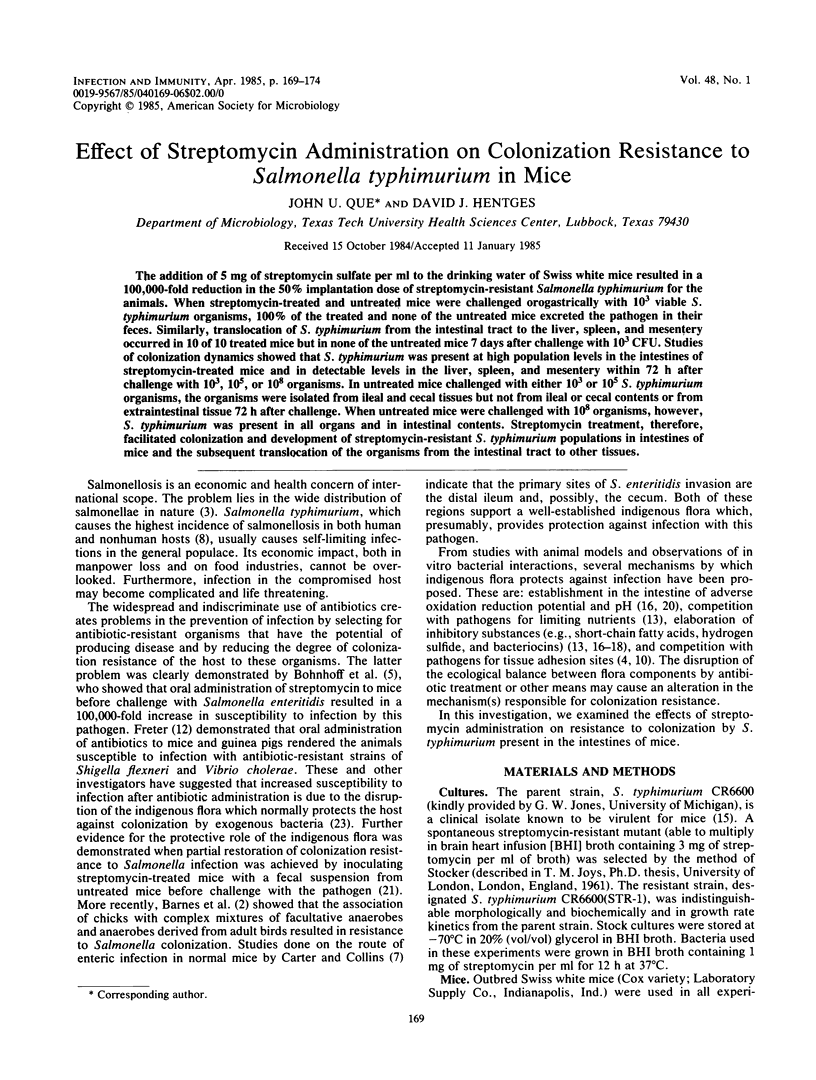
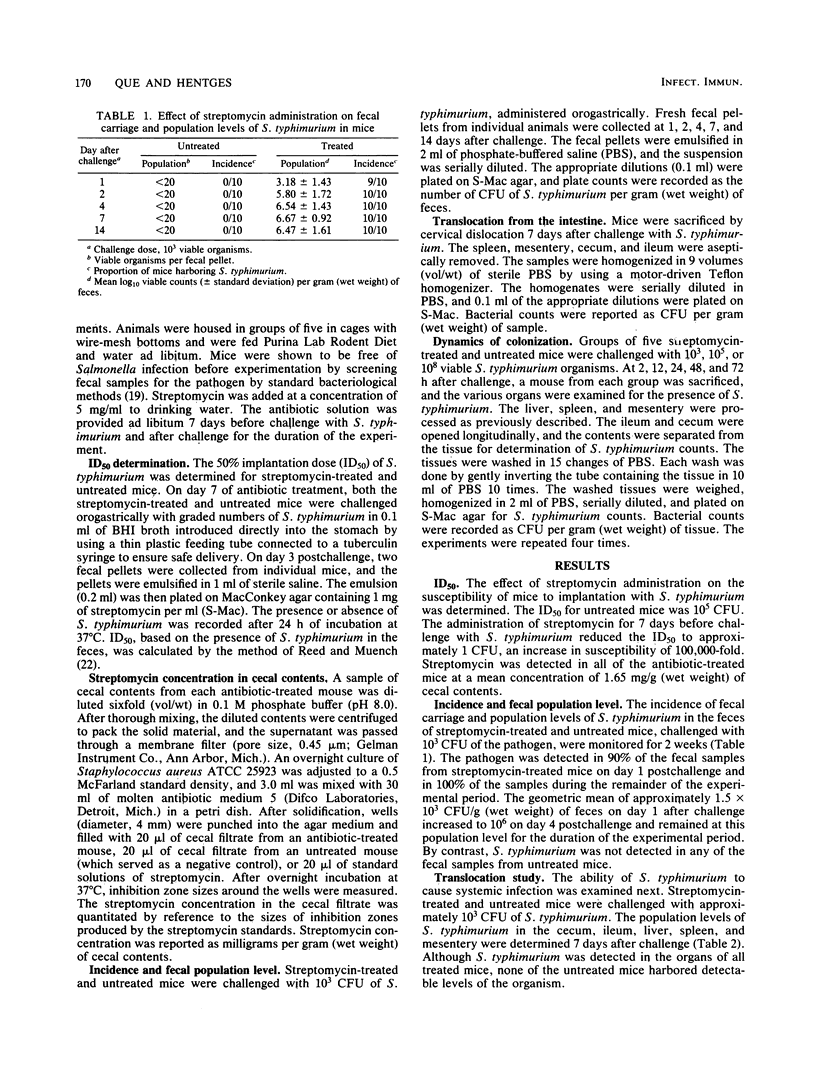
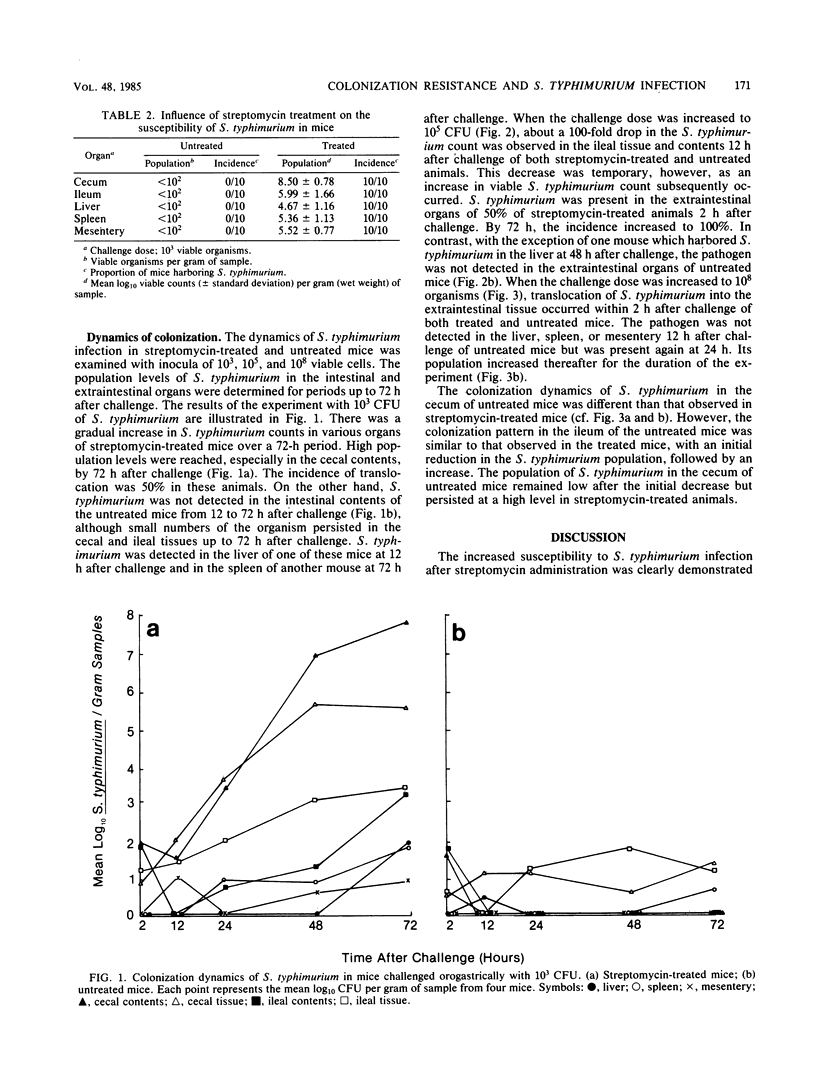
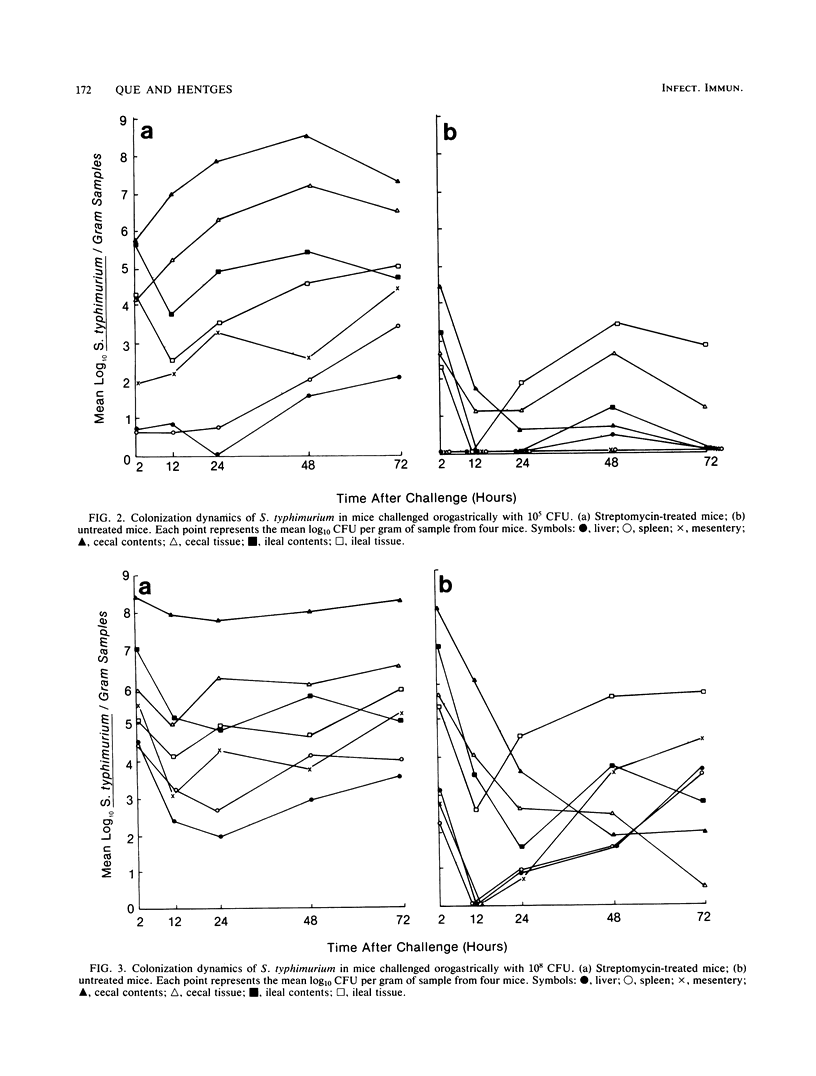
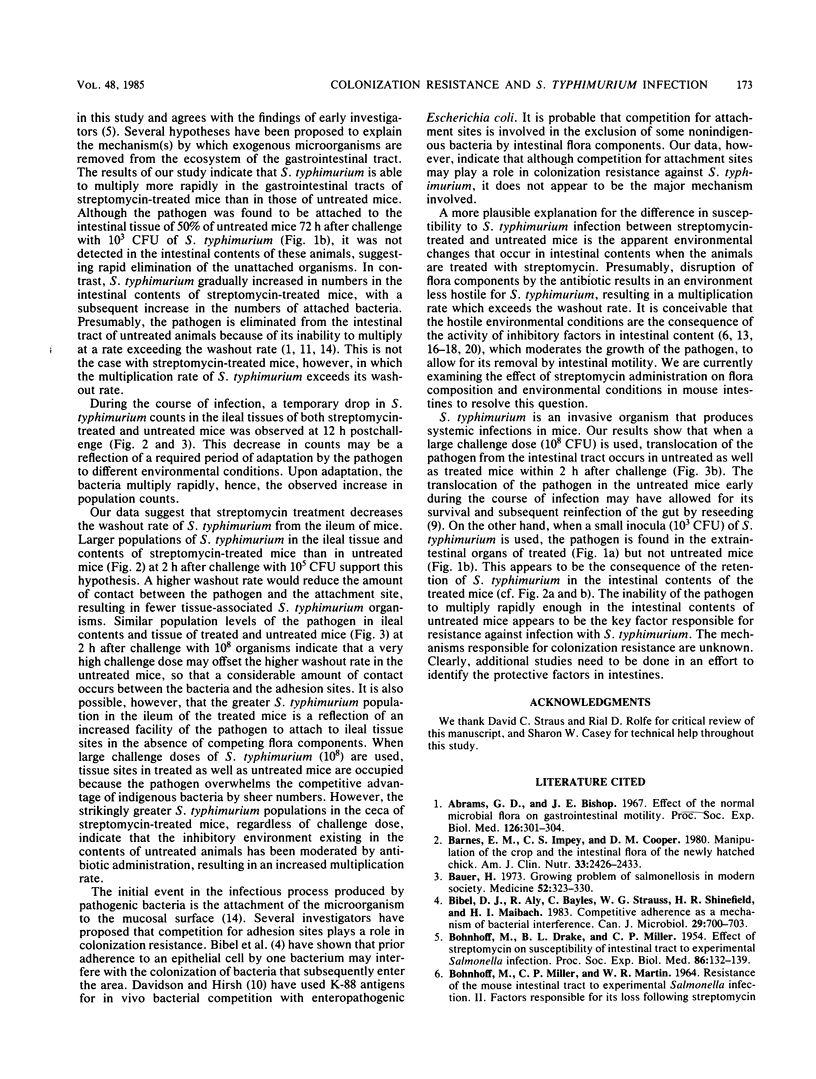
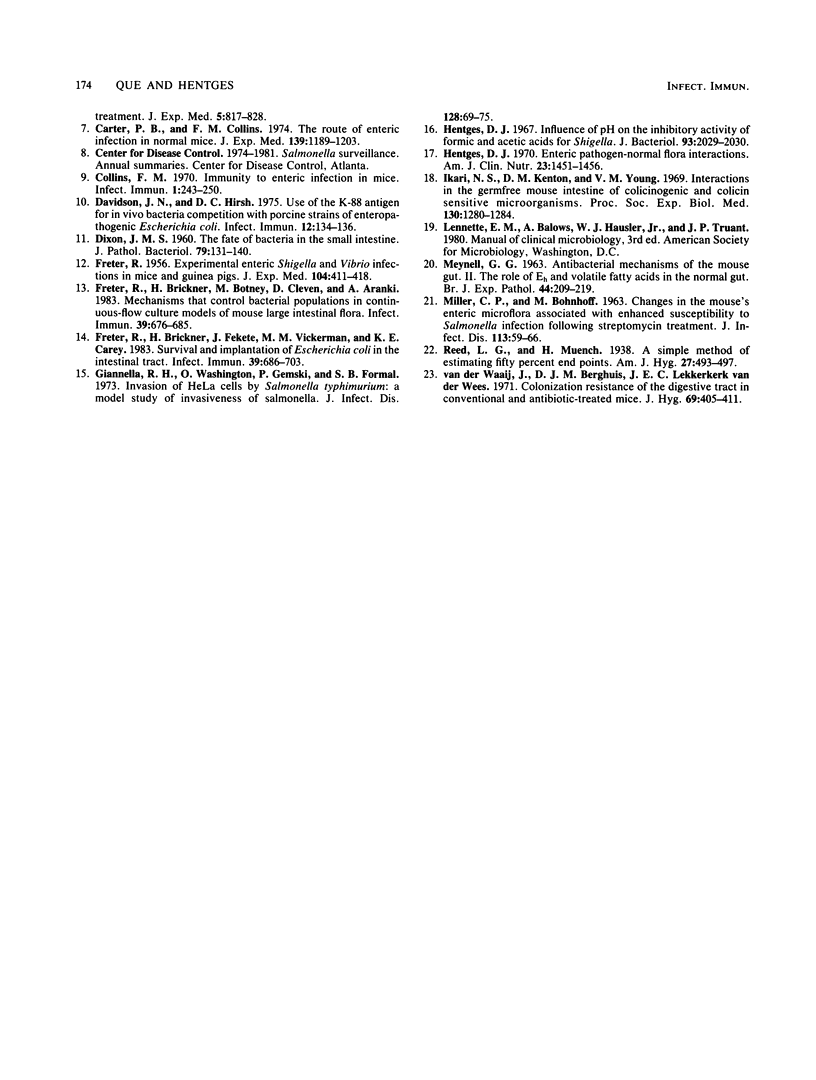
Selected References
These references are in PubMed. This may not be the complete list of references from this article.
- Abrams G. D., Bishop J. E. Effect of the normal microbial flora on gastrointestinal motility. Proc Soc Exp Biol Med. 1967 Oct;126(1):301–304. doi: 10.3181/00379727-126-32430. [DOI] [PubMed] [Google Scholar]
- BOHNHOFF M., DRAKE B. L., MILLER C. P. Effect of streptomycin on susceptibility of intestinal tract to experimental Salmonella infection. Proc Soc Exp Biol Med. 1954 May;86(1):132–137. doi: 10.3181/00379727-86-21030. [DOI] [PubMed] [Google Scholar]
- Barnes E. M., Impey C. S., Cooper D. M. Manipulation of the crop and intestinal flora of the newly hatched chick. Am J Clin Nutr. 1980 Nov;33(11 Suppl):2426–2433. doi: 10.1093/ajcn/33.11.2426. [DOI] [PubMed] [Google Scholar]
- Bauer H. Growing problem of salmonellosis in modern society. Medicine (Baltimore) 1973 Jul;52(4):323–330. doi: 10.1097/00005792-197307000-00011. [DOI] [PubMed] [Google Scholar]
- Bibel D. J., Aly R., Bayles C., Strauss W. G., Shinefield H. R., Maibach H. I. Competitive adherence as a mechanism of bacterial interference. Can J Microbiol. 1983 Jun;29(6):700–703. doi: 10.1139/m83-114. [DOI] [PubMed] [Google Scholar]
- Carter P. B., Collins F. M. The route of enteric infection in normal mice. J Exp Med. 1974 May 1;139(5):1189–1203. doi: 10.1084/jem.139.5.1189. [DOI] [PMC free article] [PubMed] [Google Scholar]
- Collins F. M. Immunity to enteric infection in mice. Infect Immun. 1970 Mar;1(3):243–250. doi: 10.1128/iai.1.3.243-250.1970. [DOI] [PMC free article] [PubMed] [Google Scholar]
- DIXON J. M. The fate of bacteria in the small intestine. J Pathol Bacteriol. 1960 Jan;79:131–140. doi: 10.1002/path.1700790116. [DOI] [PubMed] [Google Scholar]
- Davidson J. N., Hirsh D. C. Use of the K88 antigen for in vivo bacterial competition with porcine strains of enteropathogenic Escherichia coli. Infect Immun. 1975 Jul;12(1):134–136. doi: 10.1128/iai.12.1.134-136.1975. [DOI] [PMC free article] [PubMed] [Google Scholar]
- FRETER R. Experimental enteric Shigella and Vibrio infections in mice and guinea pigs. J Exp Med. 1956 Sep 1;104(3):411–418. doi: 10.1084/jem.104.3.411. [DOI] [PMC free article] [PubMed] [Google Scholar]
- Freter R., Brickner H., Botney M., Cleven D., Aranki A. Mechanisms that control bacterial populations in continuous-flow culture models of mouse large intestinal flora. Infect Immun. 1983 Feb;39(2):676–685. doi: 10.1128/iai.39.2.676-685.1983. [DOI] [PMC free article] [PubMed] [Google Scholar]
- Freter R., Brickner H., Fekete J., Vickerman M. M., Carey K. E. Survival and implantation of Escherichia coli in the intestinal tract. Infect Immun. 1983 Feb;39(2):686–703. doi: 10.1128/iai.39.2.686-703.1983. [DOI] [PMC free article] [PubMed] [Google Scholar]
- Giannella R. A., Washington O., Gemski P., Formal S. B. Invasion of HeLa cells by Salmonella typhimurium: a model for study of invasiveness of Salmonella. J Infect Dis. 1973 Jul;128(1):69–75. doi: 10.1093/infdis/128.1.69. [DOI] [PubMed] [Google Scholar]
- Hentges D. J. Enteric pathogen--normal flora interactions. Am J Clin Nutr. 1970 Nov;23(11):1451–1456. doi: 10.1093/ajcn/23.11.1451. [DOI] [PubMed] [Google Scholar]
- Hentges D. J. Influence of pH on the inhibitory activity of formic and acetic acids for Shigella. J Bacteriol. 1967 Jun;93(6):2029–2030. doi: 10.1128/jb.93.6.2029-2030.1967. [DOI] [PMC free article] [PubMed] [Google Scholar]
- Ikari N. S., Kenton D. M., Young V. M. Interaction in the germfree mouse intestine of colicinogenic and colicin-sensitive microorganisms. Proc Soc Exp Biol Med. 1969 Apr;130(4):1280–1284. doi: 10.3181/00379727-130-33773. [DOI] [PubMed] [Google Scholar]
- MEYNELL G. G. Antibacterial mechanisms of the mouse gut. II. The role of Eh and volatile fatty acids in the normal gut. Br J Exp Pathol. 1963 Apr;44:209–219. [PMC free article] [PubMed] [Google Scholar]
- MILLER C. P., BOHNHOFF M. CHANGES IN THE MOUSE'S ENTERIC MICROFLORA ASSOCIATED WITH ENHANCED SUSCEPTIBILITY TO SALMONELLA INFECTION FOLLOWING STREPTOMYCIN TREATMENT. J Infect Dis. 1963 Jul-Aug;113:59–66. doi: 10.1093/infdis/113.1.59. [DOI] [PubMed] [Google Scholar]
- van der Waaij D., Berghuis-de Vries J. M., Lekkerkerk Lekkerkerk-v Colonization resistance of the digestive tract in conventional and antibiotic-treated mice. J Hyg (Lond) 1971 Sep;69(3):405–411. doi: 10.1017/s0022172400021653. [DOI] [PMC free article] [PubMed] [Google Scholar]


